Keysight Technologies 776D Service manual

Keysight 776D
Dual Directional Coupler
Operating and
Service Manual



ii Keysight 776D Operating And Service Manual
Notice
The information contained in this document is subject to change without
notice.
Keysight Technologies makes no warranty of any kind with regard to this
material, including, but not limited to, the implied warranties of
merchantability and fitness for a particular purpose. Keysight Technologies
shall not be liable for errors contained herein or for incidental or
consequential damages in connection with the furnishing, performance, or
use of this material.
Keysight Technologies assumes no responsibility for the use or reliability of
its software on equipment that is not furnished by Keysight Technologies.
This document contains proprietary information which is protected by
copyright. All rights are reserved. No part of this document may be
photocopied, reproduced, or translated to another language without prior
written consent of Keysight Technologies.
RESTRICTED RIGHTS LEGEND
Use, duplication, or disclosure by the U.S. Government is subject to
restrictions as set forth in subparagraph (c)(1)(ii) of the Rights in Technical
Data and Computer Software clause at DFARS 252.227-7013 for DOD
agencies, and subparagraphs (c)(1) and (c)(2) of the Commercial Computer
Software Restricted Rights clause at FAR 52.227-19 for other agencies.
Keysight Technologies
1400 Fountaingrove Parkway
Santa Rosa, CA 95403-1799, U.S.A.

iv Keysight 776D Operating And Service Manual
Warranty
Custom systems are warranted by contractual agreement between
Keysight Technologies and the customer.
Certification Keysight Technologies certifies that this product met its published
specifications at the time of shipment from the factory. Keysight
Technologies further certifies that its calibration measurements are
traceable to the United States National Institute of Standards and
Technology (NIST, formerly NBS), to the extent allowed by the Institute’s
calibration facility, and to the calibration facilities of other International
Standards Organization members.
Warranty This Keysight Technologies system product is warranted against defects in
materials and workmanship for a period corresponding to the individual
warranty periods of its component products. Instruments are warranted for a
period of one year. During the warranty period, Keysight Technologies will,
at its option, either repair or replace products that prove to be defective.
Warranty service for products installed by Keysight Technologies and
certain other products designated by Keysight Technologies will be
performed at Buyer’s facility at no charge within Keysight Technologies
service travel areas. Outside Keysight Technologies service travel areas,
warranty service will be performed at Buyer’s facility only upon Keysight
Technologies’ prior agreement and Buyer shall pay Keysight Technologies’
round trip travel expenses. In all other areas, products must be returned to a
service facility designated by Keysight Technologies.
For products returned to Keysight Technologies for warranty service, Buyer
shall prepay shipping charges to Keysight Technologies and Keysight
Technologies shall pay shipping charges to return the product to Buyer.
However, Buyer shallpay all shipping charges, duties, and taxes for products
returned to Keysight Technologies from another country.
Keysight Technologies warrants that its software and firmware designated
by Keysight Technologies for use with an instrument will execute its
programming instructions when properly installed on that instrument.
Keysight Technologies does not warrant that the operation of the
instrument, or software, or firmware will be uninterrupted or error free.
LIMITATION OF WARRANTY. The foregoing warranty shall not apply
to defects resulting from improper or inadequate maintenance by Buyer,
Buyer-supplied software or interfacing, unauthorized modification or
misuse, operation outside of the environmental specifications for the
product, or improper site preparation or maintenance.

Keysight 776D Operating And Service Manual v
NO OTHER WARRANTY IS EXPRESSED OR IMPLIED. KEYSIGHT
TECHNOLOGIES SPECIFICALLY DISCLAIMS THE IMPLIED
WARRANTIES OR MERCHANTABILITY AND FITNESS FOR A
PARTICULAR PURPOSE.
EXCLUSIVE REMEDIES. THE REMEDIES PROVIDED HEREIN ARE
BUYER’S SOLE AND EXCLUSIVE REMEDIES. KEYSIGHT
TECHNOLOGIES SHALL NOT BE LIABLE FOR ANY DIRECT,
INDIRECT, SPECIAL, INCIDENTAL, OR CONSEQUENTIAL DAMAGES,
WHETHER BASED ON CONTRACT, TORT, OR ANY OTHER LEGAL
THEORY.
YEAR 2000. Keysight Technologies warrants that each Keysight Technologies
hardware, software, and firmware product on Keysight Technologies’
Corporate Price List (dated July 1, 1998 or later) delivered under the product’s
contract of sale will be able to accurately process date data
(including, but not limited to, calculating, comparing, and sequencing) from,
into, and between the twentieth and twenty-first centuries, and the years 1999
and 2000, including leap year calculations, when used in accordance with the
product documentation provided that all other products (that is, hardware,
software, firmware) used in combination with such Keysight Technologies
product(s) properly exchange date data with it. If the agreement requires that
specific Keysight Technologies products must perform as a system in
accordance with the foregoing warranty, then that warranty will apply to those
Keysight Technologies products as a system, and Customer retains sole
responsibility to ensure the year 2000 readiness of its information technology
and business environment. The duration of this warranty extends through
January 31, 2001.
The remedies available under this warranty will be defined in, and subject to,
the terms and limitations of the warranties contained in the contract of sale. To
the extent permitted by local law, this warranty applies only to branded
Keysight Technologies products and not to products manufacture by others
that may be sold or distributed by Keysight Technologies. Nothing in this
warranty will be construed to limit any rights or remedies provided elsewhere
in the contract of sale with respect to matters other than year 2000 compliance.
Assistance Product maintenance agreements and other customer assistance agreements
are available for Keysight Technologies products.
For assistance, call your local Keysight Technologies Sales and Service
Office (refer to “Service and Support Any adjustment, maintenance, or
repair of this product must be performed by qualified personnel. Contact
your customer engineer through yourlocal Keysight Technologies Service
Center. You can find a list of local service representatives on the Web at the
address below.” on page vi).

vi Keysight 776D Operating And Service Manual
Service and Support
Any adjustment, maintenance, or repair of this product must be
performed by qualified personnel. Contact your customer engineer
through your local Keysight Technologies Service Center. You can find a
list of local service representatives on the Web at the address below.
Online assistance: www.keysight.com/find/assist
United States
(tel) 1 800 452 4844 Latin America
(tel) (305) 269 7500
(fax) (305) 269 7599
Canada
(tel) 1 877 894 4414
(fax) (905) 282-6495
Europe
(tel) (+31) 20 547 2323
(fax) (+31) 20 547 2390
New Zealand
(tel) 0 800 738 378
(fax) (+64) 4 495 8950
Japan
(tel) (+81) 426 56 7832
(fax) (+81) 426 56 7840
Australia
(tel) 1 800 629 485
(fax) (+61) 3 9210 5947
Asia Call Center Numbers
Country Phone Number Fax Number
Singapore 1-800-375-8100 (65) 836-0252
Malaysia 1-800-828-848 1-800-801664
Philippines (632) 8426802
1-800-16510170 (PLDT Subscriber
Only)
(632) 8426809
1-800-16510288 (PLDT
Subscriber Only)
Thailand (088) 226-008 (outside Bangkok)
(662) 661-3999 (within Bangkok) (66) 1-661-3714
Hong Kong 800-930-871 (852) 2506 9233
Taiwan 0800-047-866 (886) 2 25456723
People’s Republic of
China 800-810-0189 (preferred)
10800-650-0021 10800-650-0121
India 1-600-11-2929 000-800-650-1101

Keysight 776D Operating And Service Manual vii
Safety and Regulatory Information
Review this product and related documentation to familiarize yourself with
safety markings and instructions before you operate the instrument. This
product has been designed and tested in accordance with international
standards.
WARNING The WARNING notice denotes a hazard. It calls attention to a procedure,
practice, or the like, that, if not correctly performed or adhered to, could result
in personal injury. Do not proceed beyond a WARNING notice until the
indicated conditions are fully understood and met.
CAUTION The CAUTION notice denotes a hazard. It calls attention to an operating
procedure, practice, or the like, which, if not correctly performed or adhered
to, could result in damage to the product or loss of important data. Do not
proceed beyond a CAUTION notice until the indicated conditions are fully
understood and met.
Instrument Markings
When you see this symbol on your instrument, you should refer to the instrument’s
instruction manual for important information.
This symbol indicates hazardous voltages.
The laser radiation symbol is marked on products that have a laser output.
This symbol indicates that the instrument requires alternating current (ac) input.
The CE mark is a registered trademark of the European Community. If it is
accompanied by a year, it indicates the year the design was proven.
The CSA mark is a registered trademark of the Canadian Standards Association.
1SM1-A This text indicates that the instrument is an Industrial Scientific and Medical Group 1
Class A product (CISPER 11, Clause 4).
This symbol indicates that the power line switch is ON.
This symbol indicates that the power line switch is OFF or in STANDBY position.
!

viii Keysight 776D Operating And Service Manual
Safety Earth
Ground This is a Safety Class I product (provided with a protective earthing
terminal). An uninterruptible safety earth ground must be provided from the
main power source to the product input wiring terminals, power cord, or
supplied power cord set. Whenever it is likely that the protection has been
impaired, the product must be made inoperative and secured against any
unintended operation.
Before Applying Power Verify that the product is configured to match the available main power
source as described in the input power configuration instructions in this
manual. If this product is to be powered by autotransformer, make sure the
common terminal is connected to the neutral (grounded) side of the ac power
supply.

Keysight 776D Operating and Service Manual 1
Overview
This operating note contains operating information for the Keysight 776D
dual directional coupler. Since the 776D must be returned to Keysight
Technologies for repair, no service information is given. Instrument
specifications are listed in Table 1. These specifications are the performance
standards, or limits against which the instrument may be tested. Figure 1
defines the terms used in Table 1 and throughout this manual.
Figure 1 Coupler Terminology
Description The 776D is a dual directional coupler designed for use in 50-ohm coaxial
systems. In this coupler, nominal coupling is 20 dB. The coupling variation
with frequency of each auxiliary arm is marked on the nameplate opposite
the appropriate auxiliary arm.

2Keysight 776D Operating and Service Manual
Overview
Network Analyzer
Reflectometer A network analyzer with either phase magnitude display, phase gain display
or polar display, with a sweep generator with appropriate RF unit plug-in,
may be used with the 776D as a reflectometer test setup. The network
analyzer reflectometer may be used either for fixed frequency or swept
frequency measurements.
Fixed Frequency
Reflectometer A SWR meter with a sweep oscillator, with appropriate plug-in RF unit, or
other signal source may be used with the 776D as a fixed frequency
reflectometer.
Swept Frequency
Reflectometer A frequency response test set or network analyzer system together with a
sweep oscillator with appropriate plug-ins may be used as a swept frequency
reflectometer.
A SWR meter with a sweep oscillator and a 140 or 180 oscilloscope with
appropriate plug-ins may be used as a swept frequency reflectometer.

Keysight 776D Operating and Service Manual 3
Specifications
Specifications
Table 1 Specifications
Characteristics Value
Primary line insertion loss Approximately 0.35 dB maximum
Minimum directivity 1
1. Measured with Keysight sliding load.
40 dB
Nominal coupling attenuation (each secondary arm) 20 dB
Accuracy of coupling (each secondary arm) Mean coupling 20 dB + 0.5 dB
Maximum coupling variation (each secondary coupling
value) ± 1 dB of specified mean coupling value
Auxiliary arm tracking 2
2. Maximum change in coupling curve of one secondary arm relative to the other.
Equal to or less than 0.3 dB
Maximum primary line VSWR 1 1.15
Maximum auxiliary arm VSWR 1.20
Primary line power handling capacity 50 watts average or 10 kW peak
Primary line connector 3
3. Keysight Type N connectors mate with standard Type N connectors (see text)
Keysight compatible Type N connectors,
one male and one female
Auxiliary arm connectors 3Keysight compatible Type N
connectors, female
Accessories available Keysight 11511A Type N Female Shorting
Jack
Keysight 11512A Type N Male Shorting Plug
Dimension 6-5/16 in x 2-5/16 in x 1-3/4 in
(161 mm x 59 mm x 45 mm)
Net weight 2 lb (0.9 kg)

4Keysight 776D Operating and Service Manual
Installation
Installation
Initial Inspection Inspect the shipping container for damage. If the shipping container or
cushioning material is damaged, it should be kept until the contents of the
shipment have been checked for completeness and the instrument has been
checked mechanically and electrically. Procedures for checking electrical
performance are given in "“Performance Tests” on page 7". If the contents
are incomplete, if there is mechanical damage or defect, or if the instrument
does not pass the electrical performance test, notify the nearest Keysight
Technologies office. If the shipping container is damaged, or the cushioning
material shows signs of stress, notify the carrier as well as the Keysight
Technologies office. Keep the shipping materials for the carrier's inspection.
The Keysight office will arrange for repair or replacement without waiting
for claim settlement.
Mating Connectors Type N mating connectors used with the 776D should have dimensions
compatible with US Military Standard MIL-C-39012.
Operating
Environment Operate the 776D in the range from 0 °C to +55 °C and protect it from
excessive humidity.
CAUTION Do not heat cycle this coupler during use or storage. Keep coupler near room
temperature (25 °C).
Installation
Instructions
Support Weight When installing the 776D, be sure the auxilliary equipment supports its own
weight. The coupler, particularly the connectors are not designed to support
weight.
N-female Pin Depth: +0.207 inches to +0.201 inches
(effective 0 to–0.006 inches)
N-male Pin Depth: –0.207 inches to –0.213 inches
(effective 0 to –0.006 inches)

Keysight 776D Operating and Service Manual 5
Installation
CAUTION Do not drop the coupler. While the coupler probably with not break, it can be
jarred out of adjustment and the connectors can be damaged.
On the bottom of each coupler is supported by four plastic feet (part number
0361-0207). The feet are inserts in 8-32 tapped holes (0.50 in deep) and may
be removed to mount the coupler. Dimensions between mounting holes are
shown in Figure 2.
Figure 2 Dimensions of Trapped Mounting Holes
Signal Flow Signal flow is indicated in Figure 3. Coupling is indicated by arrows. The
776D is bi-directional (signal may go through the coupler in either
direction).
Figure 3 Type N Connector Dimensions

6Keysight 776D Operating and Service Manual
Storage and Shipment
Storage and Shipment
Environment The 776D may be stored in surroundings between –40 °C and +75 °C.
However, heat cycling should be avoided by storing at an even room
temperature (25 °C) if at all possible. The greater the heat cycling, the
greater chance of dimensional change ofthe printed circuit board resulting in
out-of-specification operation.
Original Packaging Containers and materials identical to those used in factory packaging are
available through Keysight Technologies offices. If the instrument is being
returned to Keysight office for servicing, attach a tag indicating the type of
service required, return address, model number, and full serial number. Also,
mark the container FRAGILE to assure careful handling. In any
correspondence, refer to the instrument by model number and full serial
number.
Other Packaging The following general instructions should be used for repackaging with
commercially available materials:
1. Wrap the instrument in heavy paper or plastic. (If shipping to a Keysight
Technologies office or service center, attach a tag indicating the type of
service required, return address, model number, and full serial number.)
2. Use a strong shipping container. A single wall carton made of
200-pound test material is adequate.
3. Use enough shock-absorbing material (3 to 4-inch layer) around all sides
of the instrument to provide firm cushion and prevent movement inside
the container.
4. Seal the shipping container securely.
5. Mark the shipping container FRAGILE to assure careful handling.

Keysight 776D Operating and Service Manual 7
Performance Tests
Performance Tests
The performance tests check the instrument’s electrical performance using
the specifications of Table 1 on page -3 as the performance standards.
Coupling Test
Specification • Mean Coupling, 20 dB ± 0.5 dB
• Maximum Coupling Variation, ± l dB of mean coupling.
Figure 4 Coupling Test Setup
Procedure 1. Set up the equipment as shown in Figure 5.
2. Set the SWR meter to maximum bandwidth, 50 dB range.
3. With 1000 Hz square-wave modulation, tune SWR meter FREQ control
for a maximum indication. Set the SWR meter GAIN control for an
indication of 0 dB on the meter.
4. Observe the waveform while sweeping the oscillator manually from 940
to 1900 MHz. If the waveform is not square:
a. Adjust the loop gain of the oscillator. If still not square,
b. Add a 10 dB attenuator to the 20 dB attenuator, and repeat step 4.
5. Adjust the gain of the SWR meter to 0 dB on the 50 dB-NORMAL
range on the SWR meter and run a calibration line on the X-Y recorder.
6. Set level to 0.5 dB and run a calibration line.
7. Set level to 1.0 dB and run a calibration line.

8Keysight 776D Operating and Service Manual
Performance Tests
8. Set level to 1.5 dB and run a calibration line.
9. Set level to 2.0 dB and run a calibration line.
10. Adjust the gain of the SWR meter for an indication of 1 dB. Remove the
20 dB attenuator and insert the 776D under test, as shown in Figure 4.
Run a test trace. See Figure 5. The test trace should have a variation of
less than ± l dB and the mean coupling should be between 19.5 and 20.5
dB.
11. Reverse the 776D under test end-for-end and repeat the test for coupling
on the other arm.
Figure 5 Coupling Test Trace

Keysight 776D Operating and Service Manual 9
Performance Tests
Directivity Test
Specification: Minimum directivity 40 dB
Figure 6 Directivity Test Setup
Procedure 1. Connect the equipment as shown in Figure 6, with the Keysight
776D under test un-terminated.
2. Set the SWR meter to maximum BANDWIDTH, and full gain on the
50 dB range.
3. Modulate the sweep oscillator with 1000 Hz square-wave modulation
and tune the SWR meter FREQ control for a peak indication.
4. Adjust the RF output for a 5 mV signal on the oscilloscope.
5. Manually sweep the oscillator from 940 to 1900 MHz while observing
the waveform. If the waveform does not remain square, adjust the ALC
loop gain of the oscillator.

10 Keysight 776D Operating and Service Manual
Performance Tests
6. With the SWR Meter set to the 50 dB-NORMAL range, adjust the
GAIN control to obtain a full-scale (0 dB) indication.
7. Terminate the 776D under test with the coaxial short. Note the SWR
Meter indication. Adjust SWR meter GAIN control to indicate half-way
between this indication and the indication in step 6. This will balance
out any source match errors. The setup is now calibrated.
8. Connect the sliding load in place of the coaxial short.
9. Remove the 40 dB pad from the crystal detector and reconnect the 776D
under test.
10. Manually slowly sweep the oscillator from 940 MHz to 1900 MHz
while rapidly phasing the sliding load. Note the minimum number of dB
down that the signal indicates on the SWR meter. Be sure to add any
SWR meter range changing and the 40 dB removed by the pad to the
indicated value. If the indication is more than 40 dB down at all
frequencies, the 776D is within specifications and no further directivity
testing need be done. If not, note the frequencies where the 776D
appears out of specification. (The 776D may not be out of specification.
The directivity signal and the signal reflected from the load may be
adding in-phase.) To find the true directivity, proceed with the following
tests.
11. Set the sweep oscillator for CW operation at the frequency where the
directivity appears to be out of specification. Phase the sliding load and
note the dB attenuation values of the maximum and minimum meter
indications. Record these indications. Subtract the smaller value from
the larger. The remainder is Ml. For example, if the indications were
–0.5 and 4.4 dB with a pad of 40 dB, the two indications are 39.5 and
44.4 dB down. The difference between the two indications is 4.9 dB
(which is Ml).
12. Refer to the Signal Separation Chart in Figure 7. Determine values for
M2, which are the two correction values to be used. Add the minimum
dB indication of step 11 to each correction value (M2). For example, if
the difference in dB (M1) is 4.9 dB, then entering the graph in Figure 7 at
4.9 dB on the vertical scale, read the two correction values of 2.1 and
13.3 dB on the horizontal scale. Add these values to the smaller of the
two dB indications. In our example, the corrected results would be 41.6
dB and 52.8 dB. In this case, since both results are better than the
specifications no further tests need be made. However, if one of the
corrected results is out of specifications, proceed to the following tests
13. Two results were determined in step 12. One of these results is the
coupler directivity and one is the load reflection, but it is not known
which is which. To identify the directivity value from the load reflection
value, loosen the sliding load center conductor lock and pull out the
center conductor a small distance. Tighten the center conductor lock.
Table of contents
Other Keysight Technologies Industrial Equipment manuals
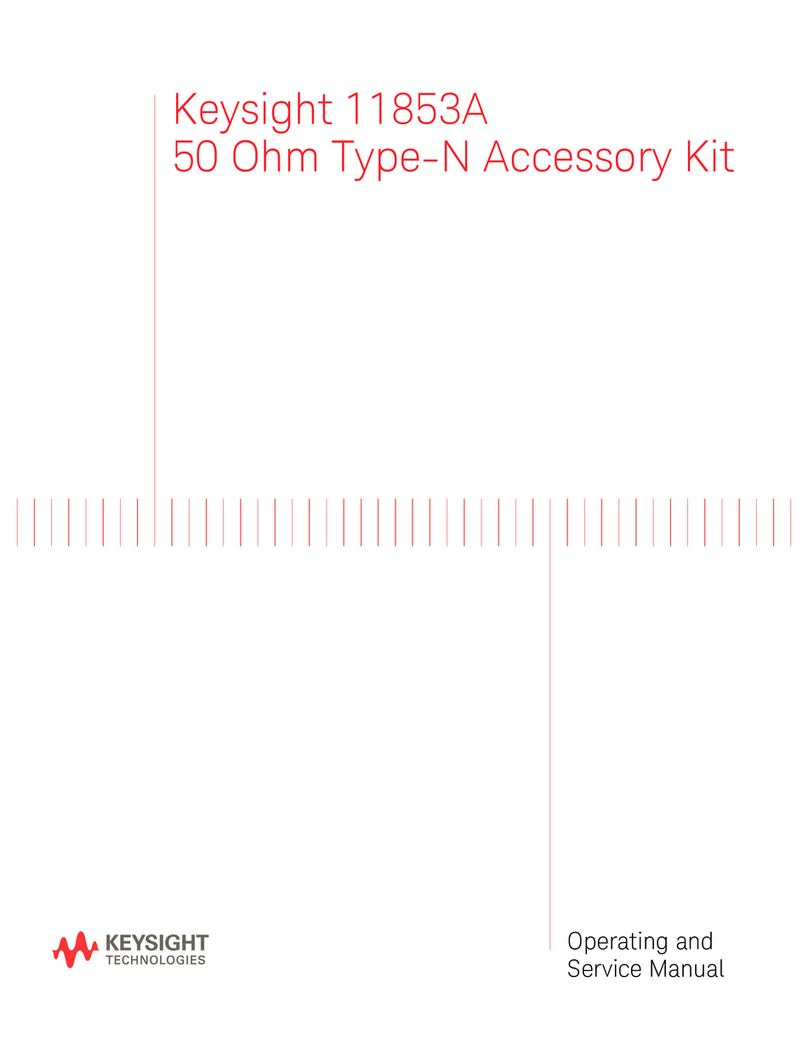
Keysight Technologies
Keysight Technologies 11853A Service manual
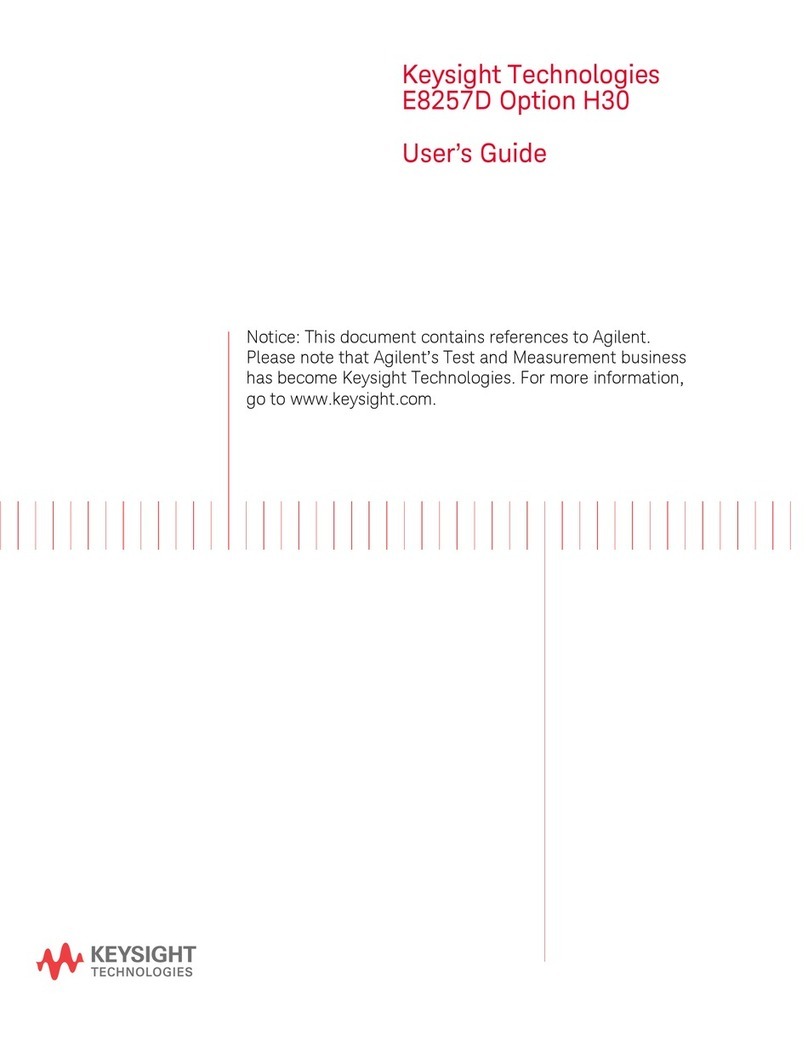
Keysight Technologies
Keysight Technologies E8257D User manual
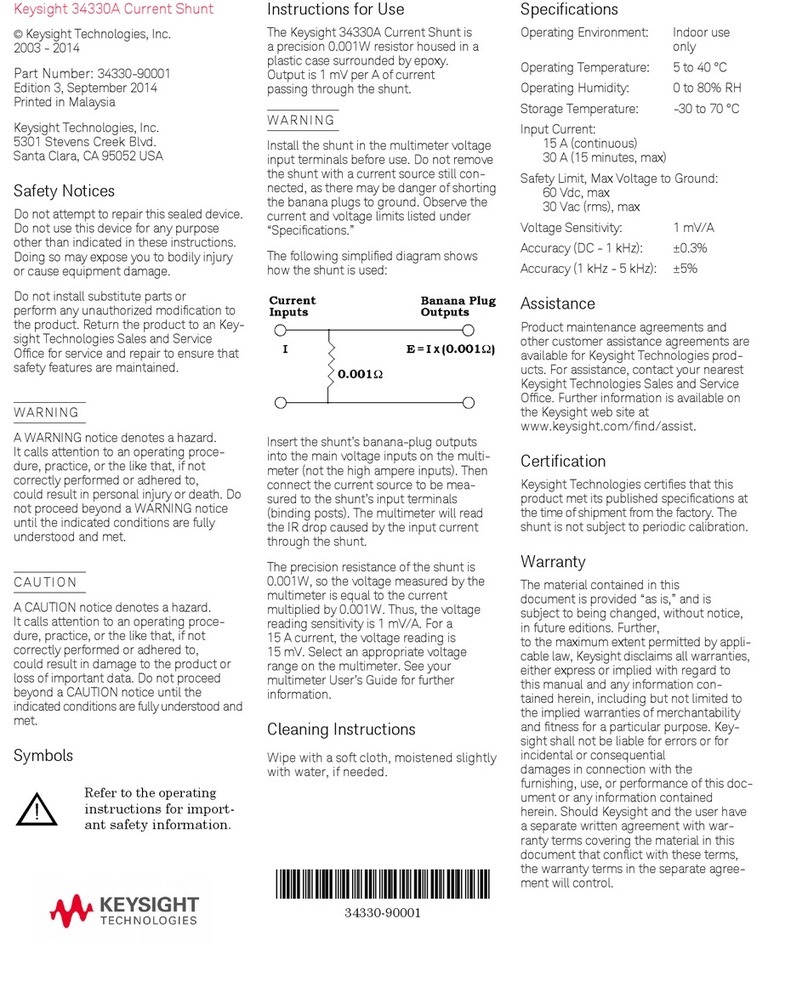
Keysight Technologies
Keysight Technologies 34330A User manual

Keysight Technologies
Keysight Technologies 16452A Operation manual
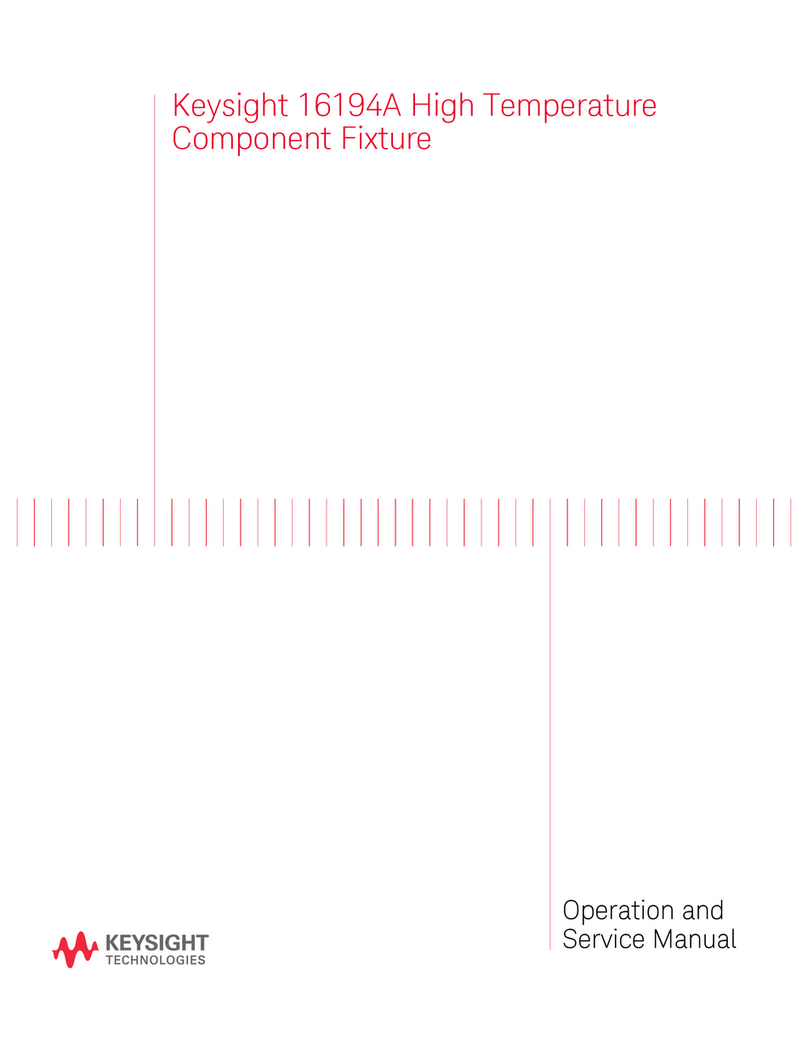
Keysight Technologies
Keysight Technologies 16194A Operation manual
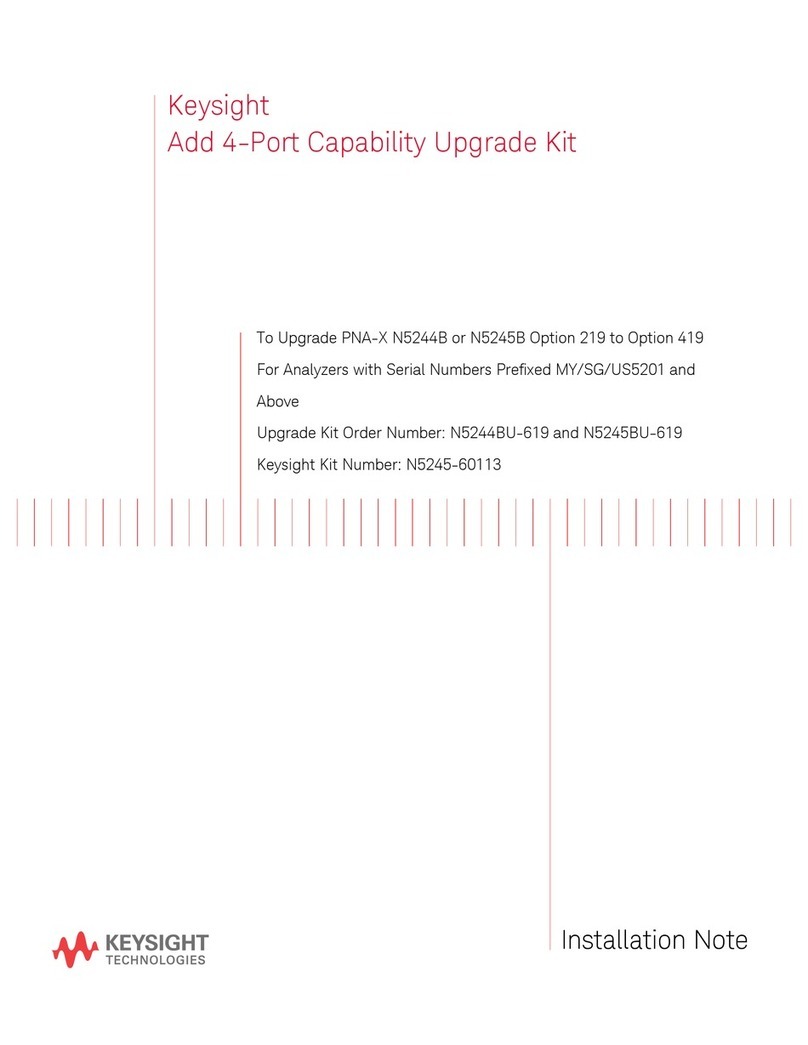
Keysight Technologies
Keysight Technologies N5245BU-619 Installation and operation manual
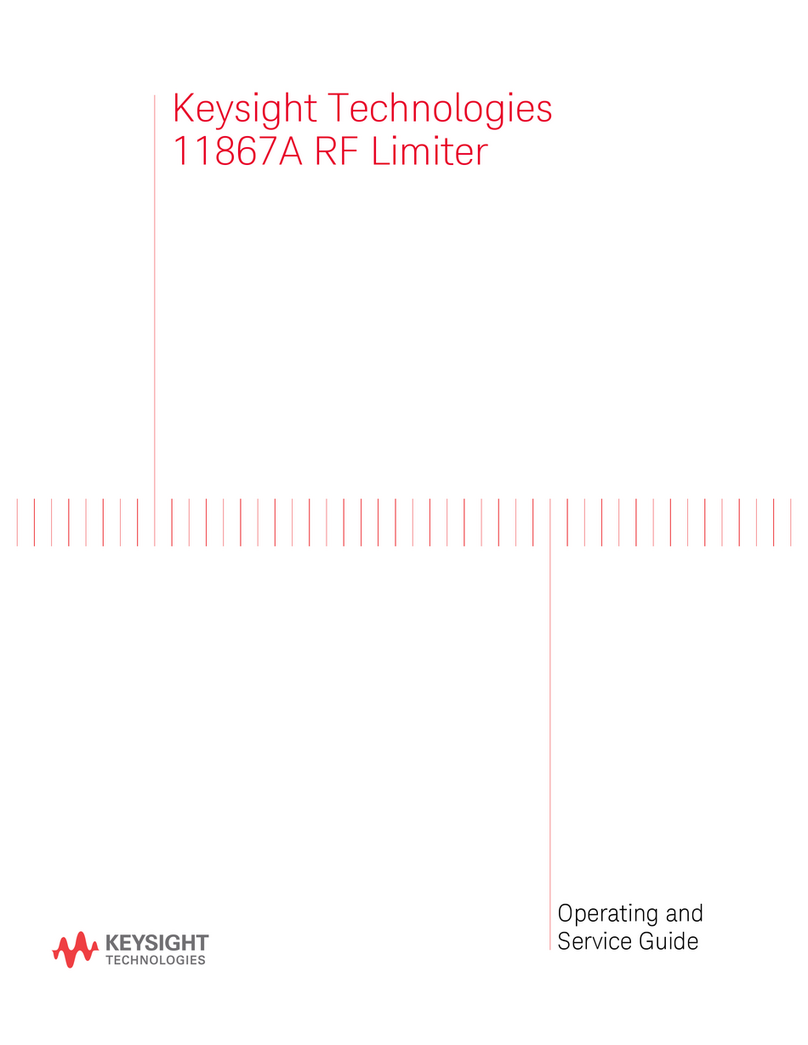
Keysight Technologies
Keysight Technologies 11867A Service manual


















